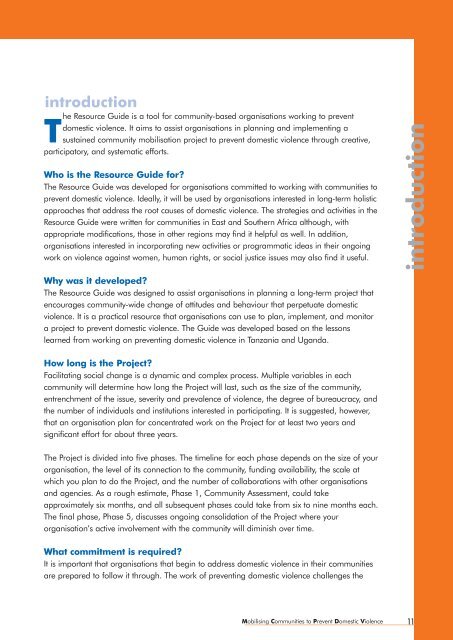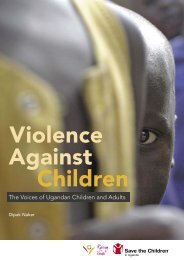Mobilising Communities to Prevent - Raising Voices
Mobilising Communities to Prevent - Raising Voices
Mobilising Communities to Prevent - Raising Voices
- No tags were found...
You also want an ePaper? Increase the reach of your titles
YUMPU automatically turns print PDFs into web optimized ePapers that Google loves.
introduction<br />
he Resource Guide is a <strong>to</strong>ol for community-based organisations working <strong>to</strong> prevent<br />
Tdomestic violence. It aims <strong>to</strong> assist organisations in planning and implementing a<br />
sustained community mobilisation project <strong>to</strong> prevent domestic violence through creative,<br />
participa<strong>to</strong>ry, and systematic efforts.<br />
Who is the Resource Guide for<br />
The Resource Guide was developed for organisations committed <strong>to</strong> working with communities <strong>to</strong><br />
prevent domestic violence. Ideally, it will be used by organisations interested in long-term holistic<br />
approaches that address the root causes of domestic violence. The strategies and activities in the<br />
Resource Guide were written for communities in East and Southern Africa although, with<br />
appropriate modifications, those in other regions may find it helpful as well. In addition,<br />
organisations interested in incorporating new activities or programmatic ideas in their ongoing<br />
work on violence against women, human rights, or social justice issues may also find it useful.<br />
Why was it developed<br />
The Resource Guide was designed <strong>to</strong> assist organisations in planning a long-term project that<br />
encourages community-wide change of attitudes and behaviour that perpetuate domestic<br />
violence. It is a practical resource that organisations can use <strong>to</strong> plan, implement, and moni<strong>to</strong>r<br />
a project <strong>to</strong> prevent domestic violence. The Guide was developed based on the lessons<br />
learned from working on preventing domestic violence in Tanzania and Uganda.<br />
introduction<br />
How long is the Project<br />
Facilitating social change is a dynamic and complex process. Multiple variables in each<br />
community will determine how long the Project will last, such as the size of the community,<br />
entrenchment of the issue, severity and prevalence of violence, the degree of bureaucracy, and<br />
the number of individuals and institutions interested in participating. It is suggested, however,<br />
that an organisation plan for concentrated work on the Project for at least two years and<br />
significant effort for about three years.<br />
The Project is divided in<strong>to</strong> five phases. The timeline for each phase depends on the size of your<br />
organisation, the level of its connection <strong>to</strong> the community, funding availability, the scale at<br />
which you plan <strong>to</strong> do the Project, and the number of collaborations with other organisations<br />
and agencies. As a rough estimate, Phase 1, Community Assessment, could take<br />
approximately six months, and all subsequent phases could take from six <strong>to</strong> nine months each.<br />
The final phase, Phase 5, discusses ongoing consolidation of the Project where your<br />
organisation’s active involvement with the community will diminish over time.<br />
What commitment is required<br />
It is important that organisations that begin <strong>to</strong> address domestic violence in their communities<br />
are prepared <strong>to</strong> follow it through. The work of preventing domestic violence challenges the<br />
<strong>Mobilising</strong> <strong>Communities</strong> <strong>to</strong> <strong>Prevent</strong> Domestic Violence<br />
11
















